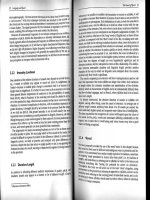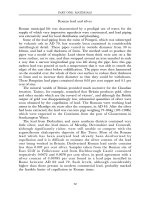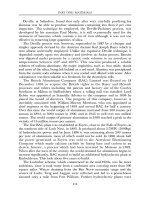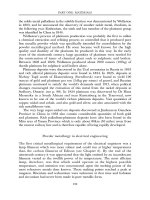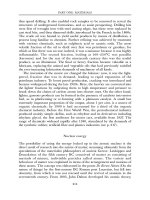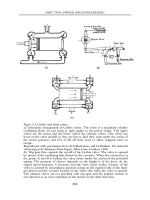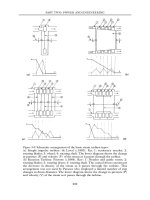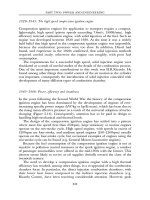An Encyclopedia of the History of Technology part 4 pps
Bạn đang xem bản rút gọn của tài liệu. Xem và tải ngay bản đầy đủ của tài liệu tại đây (102.24 KB, 10 trang )
INTRODUCTION
12
sharpened flints set into the blade with bitumen. At an oasis near the Dead
Sea, as at other places, a village grew into a city: this was Jericho, with fortified
walls and buildings, at first of reed and mud, then of unbaked clay until baked
brick was used between 8000 and 6000 BC. Barley and millet were also grown
and harvested (see Chapter 16). As well as the already domesticated dog, the
sheep, the goat and the onager, a form of ass, were added to the domestic
animals. Pottery was made not only by the old method of smoothing together
coils of clay but also on the newly invented potter’s wheel. Copper was used
for ornaments in Egypt about 4000 BC (see Chapter 1). It came 1nto more
general use for making tools 1000 years later, at about the time that tin, which
could be alloyed with it to make bronze, was discovered in Mesopotamia. Iron
was not discovered as a useful material until about 1500 BC (see Chapter 2).
Social influences of copper and iron
The social implications of copper and iron were very different. Copper, as later
bronze, was something of a rarity and consequently expensive when it had been
worked into a tool or weapon by someone with the skill and knowledge to do so.
It came, too, at a time before there was an establishment, a hierarchy of king and
priest and counsellor. Wealth was the only uncommon denominator and wealth
could be equated with worldly success in the business that mattered most—
success in agriculture. Copper tools, and weapons, thus became available only to
the powerful, to those who were already wealthy, and had the effect of increasing
their power and multiplying their wealth. It thus tended to create an elitist society
in which the majority, who formed the lower ranks, were still confined to
grubbing the earth with tools of bone and wood and stone. It was socially
divisive, helping only the rich to become richer in creating the small agricultural
surpluses that were to be at the foundation of subsequent cultures.
The technology of ironmaking and the forging of tools and weapons from the
refined metal was a more complex process, a more specialized business. On the
other hand, iron became more widely available than copper or bronze, it was far
cheaper and could be made into much better and longer lasting tools and
weapons. Thus, once the techniques and the craftsmen became established, iron
tools became more generally available to a wider spectrum of the population
than had those of copper or bronze. Iron has rightly been called the democratic
metal, the metal of the people, for so it was in comparison with its predecessor.
The common ground
On the other hand, the introduction of metallurgy, whether of bronze or
iron, and its processes did become the start of a new way of living in which
BASIC TOOLS, DEVICES AND MECHANISMS
13
specialization and the division of labour were important factors. Metal
workers were a class of specialists who needed specialist equipment and who
depended for their sustenance on the labours of their fellow men, the
farming community for whom they provided the tools. Many ancillary
trades, too, were involved, in the quarrying or mining of the ores to be
smelted. The construction of furnaces and the manufacture of crucibles were
to become other objects of specialization. The human lungs and the blowpipe
produced a very limited area of high temperature for smelting, so that the
blowpipe was virtually restricted to goldsmiths. Around 3000 BC bellows
were developed, at first from the whole skins of sheep, goats or pigs, or from
clay or wooden pots topped with a flexible membrane of leather. Copper ore
was not to be found in sufficient quantity in the ‘fertile crescent’ where it was
first used. Thus traders and carriers were required using, at first, pack
animals and later wheeled vehicles, then riverboats and sea-going ships. All
these called for further specialists to produce them. These in turn needed
further tools with which to work and added to the number of specialists who
had to be fed.
It has been suggested that copper ore was mined at Mount Sinai as early as
5000 BC and 2000 years later in Oman in the south of Arabia. These are
respectively some 1400 and 2000km (875–1250 miles) from Mesopotamia, a
long haul for the unrefined ore and a powerful incentive towards the invention
of the wheel. It was about 3500 BC that the wheel was first added to a
primitive sledge at Erech in Sumeria. Strictly speaking, the invention consisted
more of the axle to which the wheel was fixed, for previously wheel-like rollers
had been placed beneath the sledges, especially when heavy loads were
involved.
Some of the heaviest of these were the great obelisks, a characteristic of
Egyptian civilization, which were as much as 500 tonnes in weight and 37m
(122ft) h1gh when erected. They were quarried in the horizontal position, in
one piece, from around 1470 BC. It is believed that the huge blocks were cut
out of the parent granite by continual pounding from a round stone of dolerite
so as to generate a narrow trench all round; the final undercutting to separate
the obelisk must have been an awesome task. Apart from the glory brought to
the name of the pharaoh who had ordered the obelisk, it had little use except
as the gnomen of a sundial.
The plough was a vital invention for a civilization that was becoming
increasingly dependent on agriculture, and a great improvement on the hoe as
an instrument for tilling (see Figure 3). An intermediate device, which survived
in the Hebrides until the nineteenth century as the caschrom, was the
lightweight man-plough and it was not until about 3000 BC that animals
started to be harnessed to the plough or the cart. In warfare, horses were at
first used to draw two-wheeled chariots: men did not learn to ride horses until
about 2000 BC and the saddle is a much later invention which did not become
INTRODUCTION
14
truly effective until stirrups were added, allowing the horseman a better
purchase with sword or spear.
There has always been a need to join one piece of material to another, be it
wood, leather or metal, or to join wood to stone as in the hafted axe. Thongs
and cords or ropes of fibres woven together served at first, but both the nail
and the rivet were known to the coppersmiths of Egypt well before 2500 BC.
Such nails were used in sailing ships some five centuries before that date.
These again were Egyptian and represent the first known application of a
natural source of power other than animal power, the wind. The use of wind
power to drive the rotating sails of a windmill does not appear to have
occurred for another three millennia or more.
The Iron Age naturally brought with it, among other things, iron nails,
but for large timbers, such as are used in ships, where these were to be
joined, it was common to use trenails. These were no more than closely
fitting dowels and they remained the conventional method of joining ships’
and other heavy timbers until iron replaced wood as the basic construction
material in the nineteenth century AD. There is some doubt about the
woodscrew: examples exist from Roman sites between AD 400 and 450, but
in a very corroded state so that it is impossible to be sure of their purpose.
All that we know for sure is that the first illustration of a woodscrew is in
Agricola’s De Re Metallica, first published in Venice in 1566. This remarkable
and detailed work does not mention that there was anything unusual about
the woodscrew, from which it has been assumed that by that time it was an
article generally in common use.
Figure 3: The plough. The development of more effective instruments for tilling
the soil lies at the heart of agricultural production. An Egyptian hand digging
implement, c. 1500 BC. See Chapter 16.
BASIC TOOLS, DEVICES AND MECHANISMS
15
Another method of joining wood, known at least by 3000 BC, was the
mortise and tenon joint, implying the use by that date of quite sophisticated
carpenter’s tools. These must have included saws and chisels and a high
degree of skill must have been needed to use them effectively.
The first type of hinged tool, as we know it today, with two separate
components, was in fact made in one piece, depending on the spring of one
part of the metal for the relative movement between the two blades. The
Egyptians, perhaps as early as 4500 BC, had shears similar to a tailor’s
scissors (and they are still made in steel in Japan). With these they could
cut silhouettes, and it is suggested that this resulted in the Egyptian
convention of making carved or painted representations in profile. The
same principle was then applied to making tongs for those employed in
coppersmith’s work. Previously there was no alternative to holding the hot
metal between two stones.
It may appear to the reader that an excessive number of events and inventions
are recorded as having taken place in the period 3500–3000 BC. There may be
some unintentional distortion of the facts due possibly to the dating of the
earliest surviving written records. The first known writing was the cuneiform or
wedge-shaped script evolved by the Sumerians about 3400 BC. Before that
everything depended on memory and speech, the only method of recording and
recalling the past. Egyptian hieroglyphic writing followed within a couple of
centuries and by 2000 BC the Egyptians had reduced their system to an
alphabet of twenty-four letters. In contrast, the Chinese, in advance in so many
other techniques, were not so in writing. It is known that Chinese writing was
well established by 1700 BC, but the date of its origin is not known.
Pots and baskets
The development of both tools and weapons increased the demand for
containers in which to remove the spoil of excavation or to preserve or to cook
the winnings of the hunt. Basketwork is a characteristic of the Neolithic Age and
is a development of the weaving of rushes to make floor coverings for mud huts.
Such forerunners of the carpet date from some time before 5000 BC. The same
weavers learned to work in three dimensions so as to produce baskets in which
grain could be stored. By 3000 BC the skill was widespread.
Similarly pottery, in its broadest sense, did not start with the making of pots
(see Chapter 3). Long before vessels were made—as early it seems as 25,000
BC—small figures representing human beings were moulded in clay and baked,
at first, in the sun. The making of pots by coiling strips of clay in a spiral and
then moulding them together is supposed to date from about 7000 BC, as is
the moulding of clay to take the form of the inside of a basket. Sun drying
would be insufficient to produce a watertight vessel and slow baking in a kiln
INTRODUCTION
16
would be required. The kiln process was first used in Mesopotamia and Persia
around 4000 BC and in Egypt within the next thousand years.
The advance of the wheel
The inventor of the potter’s wheel wrought, perhaps, better than he knew. A
simple turntable mounted on a central pivot was turned by an assistant so that
the potter had both hands free with which to manipulate the clay. It originated
about 3500 BC in Mesopotamia, not far from Sumeria where, at about the
same time at Erech, came that great advance in technology, the addition of an
axle to a sledge on to which a wheel could be fixed, thus to form a primitive
cart or wagon. Both of these concepts were, of course, preceded by the use of a
round flat stone with a hole in the centre to act as a flywheel when spinning
thread for weaving. Doubtless the wagon at Erech was an experiment and
doubtless the same idea came to others about the same time: technology has a
habit of working like that. But to the anonymous experimenter at Erech must
go our thanks, for what would we do without wheels and axles today?
Glass
Until the plastics age of the twentieth century, and many might say into and beyond
it, glass was the ultimate material for making containers. It resists all substances—
except hydrofluoric acid. It exists in nature in the form of obsidian, a volcanic rock of
which man-made artefacts have been found, such as arrowheads. The earliest man-
made glass is dated at about 4000 BC in Egypt, as a simple glaze on beads. Not until
about the seventh century BC are Assyrian examples of small decorated jugs found,
made by casting the glass round a clay core which could then be scraped out. A great
advance was the blowing iron, allowing larger and thinner vessels to be made. This
originated in the first century under the Romans.
Gearing
We know little more of when and where gear wheels originated than we do of
the invention of the wheel. Aristotle (c. 384 BC) recorded seeing a train of
friction wheels set in motion, that is a series of contiguous wheels with smooth
peripheries but without teeth. Ctesibius of Alexandria is said, by Vitruvius, to
have constructed a water-clock with gears about 150 BC. In this, a primitive
rack was mounted on a floating drum and meshed with a circular drum so as
to rotate it. This is the earliest reference to toothed gearing, but no mention is
made of the materials used.
BASIC TOOLS, DEVICES AND MECHANISMS
17
Gearing, then, developed in two materials—in wood for large installations
transmitting power; and in metal, usually bronze or brass initially, for
timekeeping and other related astronomical instruments. The earliest surviving
‘mathematical gearing’, as the latter is known, is probably the Antikythera
mechanism now in the National Archaeological Museum, Athens, which takes
its name from that of a Greek island off which it was found in a wreck in AD
1900 and is thought to date from the first century BC. It is supposed, from the
complexity of this mechanism, of which no less than thirty-one gear wheels
survive, that this was far from the first example to be made and that, by that
date, there was an established tradition of making mathematical gearing. The
teeth on such an early example of gears were filed with a straight tooth profile
and a root angle of approximately 90 degrees.
Wooden power transmission gears for mills date at least as far back as
Roman times, a comprehensive range of carpenter’s tools being available such
as lathe, plane, bow drill, saw, chisel, awl, gimlet and rasp. It was customary at
that time to bind the ends of shafts with iron hoops as well as to line the pivot
sockets of timbers to provide a bearing surface. The blacksmith was equipped
with forge hearth, bellows, hammer, tongs and anvil by the time of Vitruvius,
who wrote about these matters in about 25 BC.
The traditions established at this time in both carpentry and blacksmithing
were to continue well into the nineteenth century with little change in
techniques but with great improvements in the products made. Improved tooth
profiles, so as to provide true rolling contact between gears, were introduced.
Bevel gears were substituted for the earlier ‘lanthorn and trundle’, the latter
being a wheel with pegs, and later shaped teeth, set into its flat surface, the
lanthorn resembling a lantern or bamboo birdcage, two discs being connected
by a number of pins or dowels equally spaced near to their periphery. The use
of wrought iron in clock gears from the Middle Ages developed into the use of
cast-iron mill gearing in the 1770s, but mortise gears—wooden teeth let into a
cast-iron rim—persisted into the nineteenth century. Hornbeam was the most
popular wood until lignum vitae, the wood of the guaiacum tree, a native of
South America, began to be imported in the eighteenth century.
Helical gears were developed by Robert Hooke in 1666. There being then
no machinery for cutting such teeth, he built them up from a series of
laminations which were staggered or progressively displaced when the faces of
the teeth were then filed smooth. Ten years later Hooke devised the universal
joint named after him and contributed much to later mechanical engineering.
Early machines in Egypt
It was not until about the time of Christ that Hero of Alexandria classified the
five basic machines as the lever, the wheel and axle, the wedge, the pulley and
INTRODUCTION
18
the screw, but the first three of these had been in common use since about
3000 BC. The shaduf for irrigation and the balance beam for weighing were
applications of the lever. It was, as we have already said, at about this time that
written records started with the Sumerian invention of cuneiform script usually
inscribed on clay tablets. The same period saw the first attempts at
standardization of weights and of linear measures, the span, the palm, the pace,
the inch and the cubit all being based on parts of the human body by the
Egyptians.
The Egyptians were also the first large-scale builders, largely using huge
quantities of slave labour rather than mechanization, or craftsmen working off
their tax dues or debts. No pulleys, for instance, were used in raising the
thousands of huge blocks of limestone for the pyramids. The great pyramid of
Cheops covered over 5.3 hectares (13 acres) and contained some 2.3 million
blocks of over 1 tonne each. It was 146m (479ft) high. Though it was a natural
progression for a civilization that had the wheel, the Egyptians did not have
the pulley. The first depiction of it is in an Assyrian relief dating from the
eighth century BC, in which it is clearly shown in use on a building site
hauling up a bucket or basket, the workman on the ground grasping a pointed
mason’s trowel.
In spite of the replacement of the blowpipe by bellows, at first operated by
hand but later by the feet, articles of iron were of limited size even towards
the end of the Egyptian Empire, that is, until about 600 BC. Drill bits,
chisels, rasps, door hinges, edging for ploughshares, bearings, spindles and
hoes are typical. Wood and stone were the principal materials of the
Egyptians. Cast iron, however, was developed by the Chinese as early as the
fourth century BC.
Greece and Rome
The Greeks were great builders but, apart from a few exceptions such as
Archimedes, were theoretical scientists rather than practical technologists.
Their contributions to sciences such as mathematics and astronomy, were
considerable—not to mention philosophy—but they were not great inventors
except, perhaps, in the production of mechanical devices to strike the
worshipping plebeians in the temples with a sense of awe. Falling weights drove
some of these, but more common was the use of hot air or hot water, even
steam being brought into service as well as a form of windmill. The Romans,
although a far more practical people, invented little of their own but did much
to adapt the principles, used by the Greeks only for their temple ‘toys’, to large-
scale practical applications such as could be used ‘for the public good’.
The Greek and Roman empires lasted for about a thousand years, from 600
BC to about AD 400, during which period the Chinese made some remarkable
BASIC TOOLS, DEVICES AND MECHANISMS
19
advances in technology. They had cast iron as early as 350 BC, some thirteen
centuries before it was known in the West; they developed the double-acting box
bellows; steel was produced in the second century BC; they invented
papermaking about AD 100. Gunpowder, mainly used in fireworks, is another
Chinese invention. It is surprising that there seems to have been so little transfer
of technology to the West in spite of so many travellers passing along the ‘Silk
Road’. These, however, were merchants or royal or papal envoys. Technology
was, perhaps, above the intellectual level of the merchants and below the notice
of the envoys. Marco Polo, for instance, in his Travels, recorded by Rustichello of
Pisa in 1298–9, records the glories of architecture, customs, weapons and
armour, food, gemstones, crops, natural history, governments and rulers but
rarely, if ever, records seeing a technological process in twenty years of
wanderings in the Middle East, India and China.
One practical invention of the Greeks was the horizontal waterwheel, the
predecessor of the turbine, now known more commonly as the Norse mill.
This was the first form of power of non-animal origin except, perhaps, the
sailing ships used by the Egyptians as early as 2500 BC. Its use spread
northwards throughout Europe. Except for the shaft from the wheel to the
millstones above and the bearings, which were usually of iron, practically the
whole construction was of wood which became the principal material of
millwrights for the next thousand years.
The Roman mill, described by Vitruvius in about AD 180, was the first
machine in which gears were used to transmit power. This mill had a vertical
wheel driving the horizontal upper millstone through lanthorn and trundle gears.
However, the Romans were well supplied with slaves and hence not encouraged
to invest in labour-saving mechanization. Watermills did not increase greatly in
number until the fourth and fifth centuries AD, towards the end of the era of the
Roman Empire. By the time of the Domesday Book, completed in AD 1086, this
survey was to record over 5600 in use in England alone, mostly used for corn
milling but possibly a few for ore crushing and for driving forge hammers.
In building, the Romans used cranes frequently fitted with a treadmill to
turn the windlass, the rope running in pulleys. The most powerful of them
were of about 6 tonnes’ lifting capacity. The stone blocks were lifted by means
of a ‘lewis’, a dovetail cut by a mason in the upper surface into which a
wedgeshaped metal anchor was fitted and locked in place by a parallel-sided
metal key. The key of the lewis and the wedged anchor could be released
when the stone had been positioned, even under water.
As well as the extensive network of roads across the Roman Empire, which
included many bridges, a great number of aqueducts were built to supply
water to their cities. The construction of river bridges often involved the
building of coffer dams of timber piles, sealed with clay, and in the building of
these two machines were used: first, the pile driver and, second, the ‘snail’ or
Archimedean screw to drain the water from the completed coffer dam.
INTRODUCTION
20
Water supply was of the greatest importance, for the Romans in the cities
are said to have used more than 270 litres (59 UK gallons, 71 US gallons) per
person per day. Rome in the fourth century AD had over 1350 fountains and
850 public baths, while flowing water was also used for flushing the plentiful
sewers. Some houses at Pompeii had as many as thirty water taps each. The
common use of lead pipes for water distribution, producing lead poisoning and
resulting in brain damage, is held by some to have been one of the causes of
the decline of the Roman Empire.
The Dark Ages
The last Roman troops left Britain in AD 436 and all contact between Britain
and Rome had ended by 450. To a great extent the Roman legacy of roads,
bridges and aqueducts died, the relics being allowed to fall into disuse and
decay, but a good deal of knowledge was preserved as well as the skills to
transmute it into practice. Many of the engineering crafts were kept alive by
the monastic orders who became rich on the basis of the products that they
made but largely from the water-powered mills that they built and operated.
The Romans, for instance, had superseded the half horsepower (or one
donkey power) Greek or Norse mill with the Vitruvian mill which generated up
to three horsepower. As civilization could no longer depend on large numbers of
slaves, there was a demand for such mechanization as was available and the
successors of the Romans continued to build water mills. At the time of the
Domesday survey there was an estimated population in England, south of the
Severn to the Trent, of nearly 1 1/2 million and hence one watermill for every
250 people, the vast majority being devoted to corn milling. Later, from AD
1000 on, mills were used for beer-making and for fulling cloth, particularly
woollen fabrics. Later applications were for forge hammers and bellows, for
paper-making, crushing woad and bark for tanning, for grinding pigments and
also for making cutlery, for water lifting and irrigation, and for saw mills, lathe
drives and wire-drawing. In the twelfth century engineers turned their attention
to harnessing wind power and the first post mills resulted. Tidal mills also
existed, but had the disadvantage that their working hours varied each day. The
first mention of a post mill is in about 1180 in Normandy. Post mills were of
necessarily limited size and hence powder, but tower mills, which first appeared
in the fourteenth century, could double or treble this. They did not come into
extensive use until the sixteenth century, particularly then in the Netherlands.
Naturally most inventions of the period were related to agricultural
improvements, textile production or building construction, or else for military
applications. Agricultural performance was greatly improved with the
development of the horse collar which transferred the load from the neck of
the horse to the shoulders, thus not interfering with its breathing. Though
BASIC TOOLS, DEVICES AND MECHANISMS
21
more costly in food, needing oats, the horse continued to replace the ox and
nailed iron shoes took the place of the earlier cord or leather sandals with
which horses had been shod. The heavy wheeled plough and the harrow also
appeared and helped to increase production. The three-field system of crop
production was introduced. In the military arena, stirrups improved the
purchase of a horseman allowing him to transfer the momentum of his mount
to the weapon in his hand, be it sword, axe or lance.
Some idea of the state of manufactures in the sixth and seventh centuries is
given by artefacts found in the excavation of the Sutton Hoo ship in 1939 near
the River Deben, not far from Ipswich in Suffolk. There an impression of a
ship, its timbers decayed and disintegrated, was found in one of seventeen
mounds, many still unopened, although there were signs that others had been
disturbed in the sixteenth century. It was, if not a royal burial place, a royal
memorial; no body was found, although there were signs of a coffin. A helmet,
a sword of gold with garnet fittings, a battle axe, a spear, silver and bronze
bowls, a gold buckle or reliquary, intricately worked and patterned, a purse of
Merovingian coins, silver-mounted drinking horns, spoons and jewellery were
among the buried treasure.
The ship itself had been carvel-built of 2.8cm (1 in) planks for sailing or
rowing by thirty-six men. It was 24m (79ft) long by 4.4m (14.5ft) beam and
some 23 tonnes displacement with an estimated speed of 14kph (7.6 knots)
when fully manned. The strakes were mounted on 7.5–12.5cm wide ribs at
9ocm centres but 45 cm apart near the stern, where a steering oar or rudder
had been fixed. A variety of iron fastenings had been used in the
construction—rib nails, keel plate spikes, steerage frame bolts, gunwhale spikes
and keel scarf nails and thole pins to form rowlocks for the oars. Once in
place, these were clenched over, after iron roves or diamond-shaped washers
had been placed over the shanks of the various fittings. The long axes of the
roves were all placed fore and aft in the vessel. The Sutton Hoo ship thus
shows a high degree of practical and artistic craftsmanship in Saxon days.
From the coins, it has been dated at about AD 630.
Some five centuries were to elapse, after its emergence in China, for the
rudder mounted on a sternpost to be adopted in Europe in the thirteenth
century. This was a great improvement on the steering oar for it was of larger
area and, being well beneath the water level, it was far less affected by the
waves. Simultaneous improvements in the rigging and an increase in hull size
meant that longer journeys could be undertaken. The properties of the
lodestone had been known since Roman times but it was not until the late
twelfth century that the compass began to appear in Europe as an aid to
navigation. The first crossing of the Atlantic was made by the Genoese
Christopher Columbus, then in the service of Spain, in 1492. He observed the
difference between magnetic and true north, a fact already known but now
confirmed from a different location.
